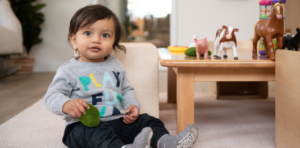

“DET FINNES IKKE DÅRLIG VÆR, BARE DÅRLIGE KLÆR”
“There is no bad weather, just bad clothes” is a Norwegian saying that most northern European families live by due to the extreme temperature lows in their Winter months. This is a stark difference to the parental attitudes in Australia. Since us Aussies are acclimated to warmer weather we all rush inside and avoid being out in the elements with the slightest sign of inclement weather.
This year at The Grove Academy, we want to escape this mindset and embrace outdoor play in all its glory with the mission to inspire and enable our children to enjoy the natural world around them and spend more time outdoors, whatever the weather.
“Don’t go out in the cold and wet, you’ll catch your death!”
Many parents fear that their children will get sick from being outside in the cold fresh air. We’re here to dispel this common Winter myth and challenge the parenting narrative that is preventing children from growing and learning in healthy ways.
A lot of adults associate Winter with catching colds and the flu, however, it is not exposure to the cold that causes these viruses. It’s more likely the increased exposure to poorly ventilated indoor environments where bacteria and viruses thrive. Getting outdoors gives children exposure to fresh air and immunity boosting Vitamin D, while avoiding that bacteria.
Studies have proven the value of dirt in boosting children’s health and combating the high rates of asthma that now affect 11.2% of Australians (that’s over 2.7 million). There has also been a microbe found in soil called, Mycobacterium vaccae, that has the ability to trigger our serotonin production, effectively making us happier and more relaxed.
“But, children can be active indoors too.”
Playing outside in Autumn, Winter, and early Spring, promotes physical development and wellbeing because outdoor play encourages the use of the whole body, offering a safe space to run, jump and exercise key muscle groups. With children spending so much time indoors these days, they fail to build strength in the most basic of ways like holding a pencil or being able to lift with their upper bodies. With this being said, the benefits of outdoor play are countless and span across more developmental areas than just physical development. Play specialist, Catherine Sewell, says:
“Don’t be too scared of the weather. It’s actually really important for children to be outside in all weather. Put on a raincoat and some gumboots and get them to experience what it’s like to be outside in the rain, and even very young children even feeling the rain on their hand; that’s a beautiful sensory experience. But being in touch with the world. So, what’s it like when it’s windy outside? What’s it like when it’s raining? What’s it like when we see the clouds moving? What’s it like when we feel the heat of the sun? Kids are learning about how they need to change their behaviour as well in different weathers. So, they’ll be hot and they’ll prefer to play in the shade, so they’re actually understanding about their body and they’re starting to learn to understand about their environment.”
“My child doesn’t like the cold and wet.”
Allowing children to move freely outdoors makes them better at assessing risk. They learn that the world isn’t cushioned for every fall, which in turn builds the courage and resilience known to be key to professional success. In Sweden, the parental attitude is one of “freedom with responsibility,” where kids are expected to learn boundaries, but as they demonstrate maturity, those boundaries expand.
If your child recoils from the cold and needs a little encouragement when the temperature drops, here are some essentials to keep them outside year-round!
- Cotton is Not Your Friend: When cotton gets wet, it traps water inside its fibres and getting wet and staying wet, even in not quite freezing temperatures, can rapidly cool your body. When the body loses heat faster than it can produce it, hypothermia can set in which is something we want to avoid.
- Thermals + Gumboots: The humble thermal sock and gumboot combo will keep little toes dry and warm during puddle jumping sessions. The cold is so much more tolerable if your feet are warm so children will be happy to stay outside longer when their feet are kept toasty.
- Invest in a Vest: Perfect for keeping bellies and backs warm without the restriction or overheating full length coats or jackets can cause. Paired with a long-sleeved t-shirt or thermal top underneath, vests are great for cutting the cold during an Australian Winter.
- Lightweight Raincoat: To lengthen your time outdoors when it’s cold and wet, it’s important to not only keep children warm, but dry as well. A lightweight raincoat to throw on when it starts to drizzle is a great way to stay dry without overheating.
- Rain Pants? While a raincoat is an obvious choice, waterproof pants can also prove invaluable when paired with the aforementioned gumboots.
- The Cherry on Top: Warms heads are important for keeping your body warm, especially when you consider the head to body ratio of small children. Alternatively, fleece ear muffs or ear covering headbands keep little ears warm without overheating. Some children can be particularly bothered by cold ears, and an earache can put an end to your outdoor play pretty quickly.
- End on a High: There’s nothing like a hot chocolate or milo after some cold or wet weather play. If a sugar high isn’t what you’re after, a steaming bowl of your favourite soup will warm those bellies up just the same.
Accommodating outdoor play throughout the entire year builds healthy, resilient and confident kids and is crucial for their ongoing development. If your child attends a Grove campus, please ensure they are dressed appropriately and have adequate changes of clothes packed each day.







